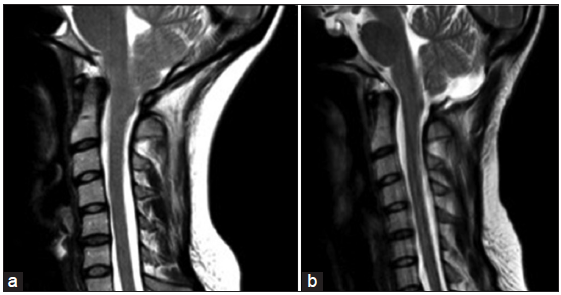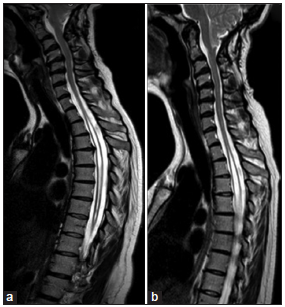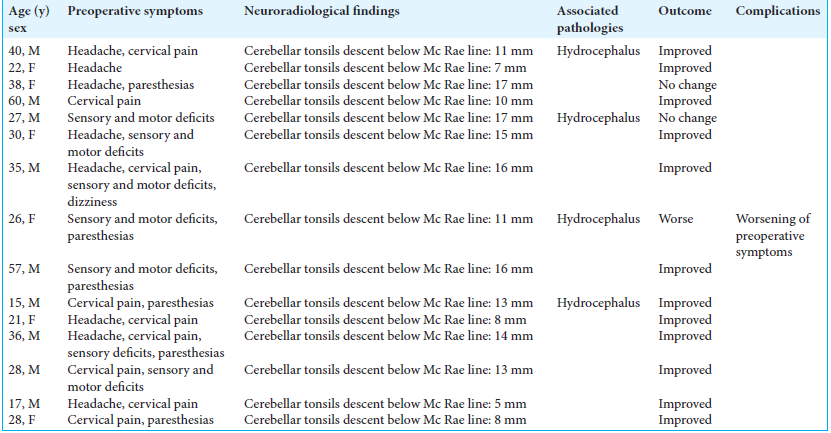- Department of Biomedical and Dental Sciences and Morphofunctional Imaging, Unit of Neurosurgery, University of Messina, Messina, Italy.
- Department of Diagnostics and Public Health, University of Verona, Verona, Italy.
Correspondence Address:
Gerardo Caruso
Department of Biomedical and Dental Sciences and Morphofunctional Imaging, Unit of Neurosurgery, University of Messina, Messina, Italy.
DOI:10.25259/SNI-70-2019
Copyright: © 2019 Surgical Neurology International This is an open-access article distributed under the terms of the Creative Commons Attribution-Non Commercial-Share Alike 4.0 License, which allows others to remix, tweak, and build upon the work non-commercially, as long as the author is credited and the new creations are licensed under the identical terms.How to cite this article: Maria Caffo, Salvatore M. Cardali, Gerardo Caruso, Elena Fazzari, Rosaria V. Abbritti, Valeria Barresi, Antonino Germanò. Minimally invasive posterior fossa decompression with duraplasty in Chiari malformation type I with and without syringomyelia. 10-May-2019;10:88
How to cite this URL: Maria Caffo, Salvatore M. Cardali, Gerardo Caruso, Elena Fazzari, Rosaria V. Abbritti, Valeria Barresi, Antonino Germanò. Minimally invasive posterior fossa decompression with duraplasty in Chiari malformation type I with and without syringomyelia. 10-May-2019;10:88. Available from: http://surgicalneurologyint.com/surgicalint-articles/9344/
Abstract
Background: Posterior fossa decompression (PFD), with and without duraplasty, represents a valid treatment in Chiari malformation Type I (CM-I) with and without syringomyelia. Despite a large amount of series reported in literature, several controversies exist regarding the optimal surgical approach yet. In this study, we report our experience in the treatment of CM-I, with and without syringomyelia, highlighting how the application of some technical refinements could lead to a good outcome and a lesser rate of complications.
Methods: Twenty-six patients with CM-I, with and without syringomyelia, underwent PFD through a 3 cm × 3 cm craniectomy with the removal of the most median third of the posterior arch of C1 and duraplasty. Signs and symptoms included sensory deficits, motor deficits, neck pain, paresthesias, headache, dizziness, lower cranial nerve deficits, and urinary incontinence. Postoperative magnetic resonance (MR) was performed in all patients.
Results: Signs and symptoms improved in 76.9% of cases. Postoperative MR revealed a repositioning of cerebellar tonsils and the restoration of cerebrospinal fluid circulation. In our experience, the rate of complication was 23% (fistula, worsening of symptoms, and respiratory impairment).
Conclusion: PFD through a 3 cm × 3 cm craniectomy and the removal of the most median third of posterior arch of C1 with duraplasty represents a feasible and valid surgical alternative to treat patients with CM-I, with and without syringomyelia, achieving a good outcome and a low rate of complications.
Keywords: Cerebellar tonsils, Chiari malformation type I, Duraplasty, Posterior fossa decompression, Syringomyelia
INTRODUCTION
The pathophysiology of Chiari malformation Type I (CM-I) involves frequently the small posterior cranial fossa[
Surgical management of CM-I with and without syringomyelia is a still controversial topic in neurosurgery. Among the numerous methods proposed, the posterior fossa decompression (PFD) would seem to be the most suitable in the treatment of CM-I. PFD allows the relief of the cerebellar tonsils from the dorsal surface of the brainstem and upper cervical spinal cord, allowing physiologic and better CSF dynamics. A large amount of data demonstrated that PFD with or without removal of posterior arch of C1, and with or without duraplasty, allows an increase of volume of the posterior fossa, the repositioning of the herniated cerebellar tonsils, and the restoration of CSF circulation. However, few data exist regarding the dimension of craniectomy correlating this aspect to clinical outcome, neuroradiological findings, and rate of complications.
We performed, in 26 patients, a 3 cm × 3 cm craniectomy, with the removal of the most median third of the posterior arch of C1 and duraplasty with heterologous patches. In the light of our results and after a careful evaluation of the relevant literature, we think that this surgical strategy could represent a reliable and feasible approach to achieve a good outcome and a low rate of complications.
MATERIALS AND METHODS
Patients selection and data collection
A retrospective review of medical records of 26 patients, affected by CM-I with and without syringomyelia, undergone surgery from 2004 to 2014, was conducted. The epidemiological information, clinical presentation, duration of symptoms, radiological findings, and the clinical outcome were determined. All patients underwent brain and spine magnetic resonance (MR) study preoperatively.
Surgical technique
The patients were positioned in prone position, with the head in slight flexion and fixed with the Kees-Mayfield three-pin head holder. A midline skin incision is performed starting 1 cm above the inion to the spinous process of C2. The fascia and muscles were incised and dissected in a subperiosteal fashion until the occipital bone and the posterior arch of C1 were exposed. A 3 cm × 3 cm suboccipital craniectomy was realized. The decompression was completed through the removal of the most median third of the posterior arch of C1 beneath and contiguous to the craniectomy [
Follow-up and outcomes
Patients’ clinical examinations were compared with their preoperative examinations in the 1st, 6th, and 12th months after surgery. A postoperative MR imaging study was performed at each follow-up control [
Figure 2
(a) T2 magnetic resonance (MR) weighted images showing the descent of cerebellar tonsils through the foramen magnum and the compression of the medulla oblongata, (b) T2-weighted postoperative MR in sagittal plane demonstrates the repositioning of cerebellar tonsils and the enlargement of subarachnoid spaces of posterior cranial fossa.
RESULTS
The study included 26 patients, 12 males and 14 females. The mean age at surgery was 35.8 years. The patients were divided into two groups. The former is made up of CM-I patients without syringomyelia, while the second is from patients with CM-I associated with syringomyelia. The characteristics of both series are summarized in
The first series included patients with CM-I without associated syringomyelia. This series included 15 patients, aged between 15 and 60 years. Symptoms at presentation are listed in
The second series consisted of patients affected by CM-I with associated syringomyelia. This series included 11 patients, aged between 16 and 67 years. Symptoms at presentation are listed in
Progressive reduction in syrinx volume was observed in 8 patients (72.7%) [
DISCUSSION
CM-I includes a group of entities of congenital or acquired etiology that has in common the caudal displacement of the cerebellar tonsils through the foramen magnum into the cervical canal. This may be due to the underdevelopment of occipital somites from paraxial mesoderm. As a result, a small posterior fossa is developed predisposing to a downward herniation of its contents, i.e., cerebellar tonsils migrating to cervical spinal canal. In 50%– 76% of patients, the malformation is associated with hydromyelic cavitation of the spinal cord and medulla oblongata.[
Although the pathogenesis of CM-I is still mattered of debate, the posterior fossa volume mismatch is the leading cause of CM-I. Marin-Padilla showed that CM-I may be caused by a mesodermal insufficiency occurring after closure of the neural folds.[
MR represents the optimal tool in the diagnosis since it is noninvasive and has a good correlation with clinical findings. Cine flow MR studies have recently been introduced into clinical use and have gained importance in decision-making of the ideal surgical procedure.[
Indications for surgery include the presence of neurological symptoms, their progression, and/or headache caused by herniation of the cerebellar tonsils and significantly deteriorating the patients’ quality of life. However, nowadays, there is still considerable controversy about the optimal surgical procedure for the treatment of CM-I with or without syringomyelia. In cases characterized by symptoms clearly attributable to syringomyelia, shunting of the syringomyelic cavity is indicated, based on fluid diversion in the subarachnoid space or into extracavitary locations (peritoneal and pleural cavities). However, in these cases, treated with shunting procedures, the cause is not removed and the pathogenetic mechanism persists. PFD with and without cervical laminectomy is the preferred treatment option that allowing a satisfactory CSF flow restoration and tonsillar repositioning.[
Despite several series have been published about the choice of approach in terms of PFD, the dimension of craniectomy still represents matter of debate, due to few data exist in literature. The optimal extent of bony removal varies from surgeon to surgeon. A reduced craniectomy could cause an inadequate decompression, while a large craniectomy might theoretically allow an abnormal dural distention and the descent of the cerebellar tonsils through the bony defect. Sindou et al. analyzed the clinical outcome of a series of 44 patients affected by CM-I with and without syringomyelia.[
The objective of the craniectomy should be to restore the volume of the cisterna magna and decompress the brainstem. An excessively wide craniectomy could cause cerebellar herniation into spinal canal and compression on brainstem, obstruction of the liquoral circulation, and formation of arachnoidal scarring. In the light of these observations, in our series, we performed a suboccipital 3 cm × 3 cm2 craniectomy combined with the removal of the most median third of the posterior arch of C1, below and contiguous to the craniectomy. This phase allows us a sufficient decompression of the posterior cranial fossa and the restoration of CSF flow at CVJ.
Published series reports clinical improvement rates after surgical treatment from 71% to 100%[
Fenestration of the arachnoid plane is still mattered of debate; some authors claim that preservation of arachnoidal layer, likewise dura mater, is associated to lower risk of CSF-related complication and is a safe and effective surgical option, mainly when no evidence of arachnoiditis or obstruction of the outflow at the level of foramen of Magendie occurs.[
Another critical issue is the duraplasty. Some authors published that PFD with duraplasty is more effective than PFD alone.[
The choice of dural substitute is a critical topic. Attenello et al. compared the use of pericranium autograft and synthetic expanded polytetrafluoroethylene (ePTFE) in pediatric patients. Both dural grafts were associated to a great rate of clinical improvement and a minimal incidence of complications; ePTFE provided an earlier improvement in syringomyelia than autologous graft, without differences in absolute incidence.[
CONCLUSION
Although CM-I physiopathology is still unclear, signs and symptoms could be attributed to a CSF flow impairment due to an overcrowding of posterior fossa structures. The main goal of surgical treatment is to restore a normal outflow at CVJ. Our treatment option is a suboccipital 3 × 3 craniectomy, the removal of the median part of C1 arch, and duraplasty with bovine dural graft or Gore-Tex patch. We can consider satisfactory our clinical results and our rate of complications, even more if compared with the data reported in literature. This technique can be considered a valid and safe choice for the treatment of CM-I.
References
1. Alfieri A, Pinna G. Long-term results after posterior fossa decompression in syringomyelia with adult chiari Type I malformation. J Neurosurg Spine. 2012. 17: 381-7
2. Arnautovic A, Splavski B, Boop FA, Arnautovic KI. Pediatric and adult chiari malformation Type I surgical series 1965-2013: A review of demographics, operative treatment, and outcomes. J Neurosurg Pediatr. 2015. 15: 161-77
3. Attenello FJ, McGirt MJ, Garcés-Ambrossi GL, Chaichana KL, Carson B, Jallo GI. Suboccipital decompression for chiari I malformation: Outcome comparison of duraplasty with expanded polytetrafluoroethylene dural substitute versus pericranial autograft. Childs Nerv Syst. 2009. 25: 183-90
4. Batzdorf U, McArthur DL, Bentson JR. Surgical treatment of chiari malformation with and without syringomyelia: Experience with 177 adult patients. J Neurosurg. 2013. 118: 232-42
5. Chai Z, Xue X, Fan H, Sun L, Cai H, Ma Y. Efficacy of posterior fossa decompression with duraplasty for patients with chiari malformation Type I: A systematic review and meta-analysis. World Neurosurg. 2018. 113: 357-650
6. Chauvet D, Carpentier A, Allain JM, Polivka M, Crépin J, George B. Histological and biomechanical study of dura mater applied to the technique of dura splitting decompression in chiari Type I malformation. Neurosurg Rev. 2010. 33: 287-94
7. Chen J, Li Y, Wang T, Gao J, Xu J, Lai R. Comparison of posterior fossa decompression with and without duraplasty for the surgical treatment of chiari malformation Type I in adult patients: A retrospective analysis of 103 patients. Medicine (Baltimore). 2017. 96: e5945-
8. Chotai S, Kshettry VR, Lamki T, Ammirati M. Surgical outcomes using wide suboccipital decompression for adult chiari I malformation with and without syringomyelia. Clin Neurol Neurosurg. 2014. 120: 129-35
9. Chotai S, Medhkour A. Surgical outcomes after posterior fossa decompression with and without duraplasty in chiari malformation-I. Clin Neurol Neurosurg. 2014. 125: 182-8
10. El-Ghandour NM. Long-term outcome of surgical management of adult chiari I malformation. Neurosurg Rev. 2012. 35: 537-47
11. Forander P, Sjavik K, Solheim O, Riphagen I, Gulati S, Salvesen Ø. The case for duraplasty in adults undergoing posterior fossa decompression for chiari I malformation: A systematic review and meta-analysis of observational studies. Clin Neurol Neurosurg. 2014. 125: 58-64
12. Furtado SV, Thakar S, Hegde AS. Correlation of functional outcome and natural history with clinicoradiological factors in surgically managed pediatric chiari I malformation. Neurosurgery. 2011. 68: 319-28
13. Gambardella G, Caruso G, Caffo M, Germanò A, La Rosa G, Tomasello F. Transverse microincisions of the outer layer of the dura mater combined with foramen magnum decompression as treatment for syringomyelia with chiari I malformation. Acta Neurochir. 1998. 140: 134-9
14. Guyotat J, Bret P, Jouanneau E, Ricci AC, Lapras C. Syringomyelia associated with Type I chiari malformation. A 21-year retrospective study on 75 cases treated by foramen magnum decompression with a special emphasis on the value of tonsils resection. Acta Neurochir. 1998. 140: 745-54
15. Hu Y, Liu J, Chen H, Jiang S, Li Q, Fang Y. A minimally invasive technique for decompression of chiari malformation Type I (DECMI study): Study protocol for a randomized controlled trial. BMJ Open. 2015. 5: e007869-
16. Hwang HS, Moon JG, Kim CH, Oh SH, Song JH, Jeong JH. The comparative morphometric study of the posterior cranial fossa: What is effective approaches to the treatment of chiari malformation Type 1?. J Korean Neurosurg Soc. 2013. 54: 405-10
17. Klekamp J, Batzdorf U, Samii M, Bothe HW. The surgical treatment of chiari I malformation. Acta Neurochir. 1996. 138: 788-801
18. Klekamp J. Surgical treatment of chiari I malformation analysis of intraoperative findings, complications, and outcome for 371 foramen magnum decompressions. Neurosurgery. 2012. 71: 365-80
19. Lazareff JA, Galarza M, Gravori T, Spinks TJ. Tonsillectomy without craniectomy for the management of infantile chiari I malformation. J Neurosurg. 2002. 97: 1018-22
20. Lee HS, Lee SH, Kim ES, Kim JS, Lee JI, Shin HJ. Surgical results of arachnoid-preserving posterior fossa decompression for chiari I malformation with associated syringomyelia. J Clin Neurosci. 2012. 19: 557-60
21. Lee CK, Mokhtari T, Connolly ID, Li G, Shuer LM, Chang SD. Comparison of porcine and bovine collagen dural substitutes in posterior fossa decompression for chiari I malformation in adults. World Neurosurg. 2017. 108: 33-40
22. Linge SO, Haughton V, Løvgren AE, Mardal KA, Helgeland A, Langtangen HP. Effect of tonsillar herniation on cyclic CSF flow studied with computational flow analysis. Am J Neuroradiol. 2011. 32: 1474-81
23. Ma J, You C, Chen H, Huang S, Ieong C. Cerebellar tonsillectomy with suboccipital decompression and duraplasty by small incision for chiari I malformation (with syringomyelia): Long term follow-up of 76 surgically treated cases. Turk Neurosurg. 2012. 22: 274-9
24. Marin-Padilla M, Marin-Padilla TM. Morphogenesis of experimentally induced Arnold-chiari malformation. J Neurol Sci. 1981. 50: 29-55
25. Noudel R, Jovenin N, Eap C, Scherpereel B, Pierot L, Rousseaux P. Incidence of basioccipital hypoplasia in chiari malformation Type I: Comparative morphometric study of the posterior cranial fossa. J Neurosurg. 2009. 111: 1046-52
26. Oldfield EH. Pathogenesis of chiari I-pathophysiology of syringomyelia: Implications for therapy: A summary of 3 decades of clinical research. Neurosurgery. 2017. 64: 66-77
27. Pueyrredon F, Spaho N, Arroyave I, Vinters H, Lazareff J. Histological findings in cerebellar tonsils of patients with chiari Type I malformation. Childs Nerv Syst. 2007. 23: 427-9
28. Sindou M, Chàvez-Machuca J, Hashish H. Cranio-cervical decompression for chiari Type I-malformation, adding extreme lateral foramen magnum opening and expansile duroplasty with arachnoid preservation. Technique and long-term functional results in 44 consecutive adult cases comparison with literature data. Acta Neurochir. 2002. 144: 1005-19
29. Williams B. The distending force in the production of communicating syringomyelia. Lancet. 1970. 2: 41-2
30. Williams LE, Vannemreddy PS, Watson KS, Slavin KV. The need in dural graft suturing in chiari I malformation decompression: A prospective, single-blind, randomized trial comparing sutured and sutureless duraplasty materials. Surg Neurol Int. 2013. 4: 26-










